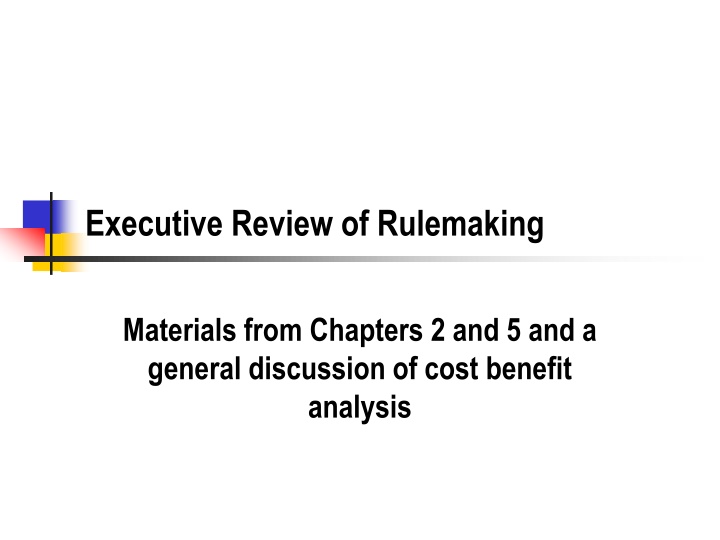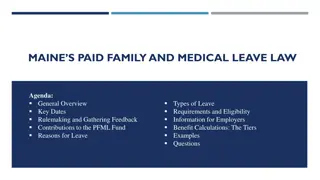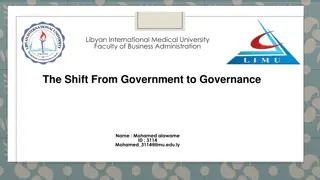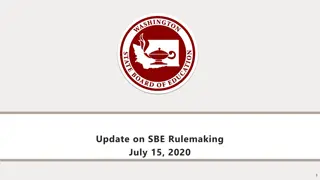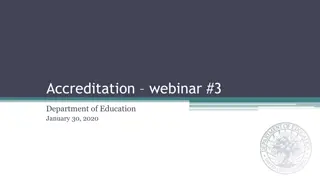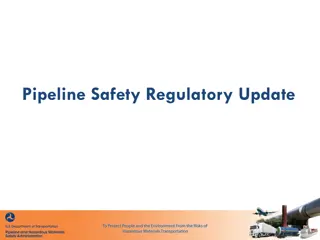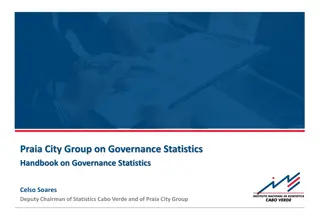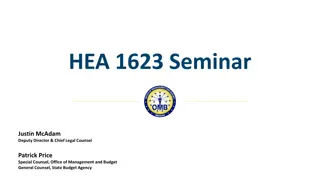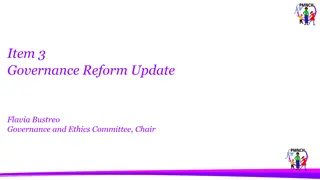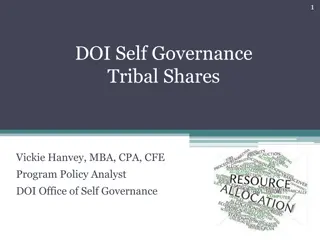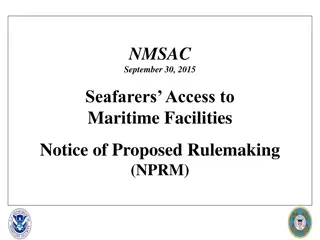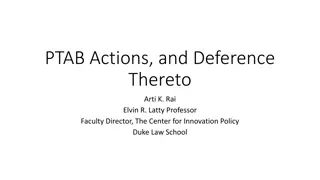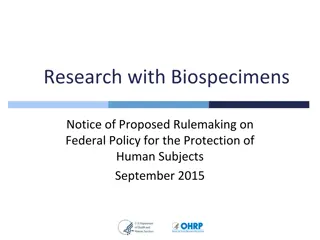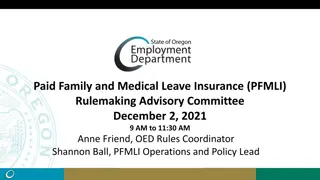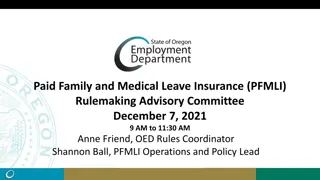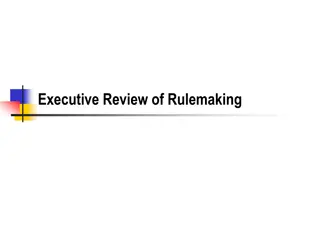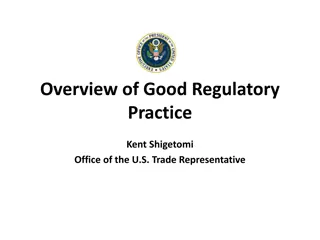Comprehensive Analysis of Rulemaking in Regulatory Governance
The executive review delves into regulatory materials from various chapters, highlighting both successes and failures within the regulatory landscape. It explores the tension in rulemaking, public perception of risk, and the role of non-agency regulation in tort and compensation law. The discussion also covers approaches to regulation and the challenges posed by crisis-driven regulatory measures.
Download Presentation

Please find below an Image/Link to download the presentation.
The content on the website is provided AS IS for your information and personal use only. It may not be sold, licensed, or shared on other websites without obtaining consent from the author.If you encounter any issues during the download, it is possible that the publisher has removed the file from their server.
You are allowed to download the files provided on this website for personal or commercial use, subject to the condition that they are used lawfully. All files are the property of their respective owners.
The content on the website is provided AS IS for your information and personal use only. It may not be sold, licensed, or shared on other websites without obtaining consent from the author.
E N D
Presentation Transcript
Executive Review of Rulemaking Materials from Chapters 2 and 5 and a general discussion of cost benefit analysis
Regulatory Successes Public health - Life expectancy from 25 to nearly 80. Food and drug safety - compared to 1900 Environmental regulation Workplace safety Civil rights Banking Lots of moral hazard problems, which blew up in 2008 No one lost insured deposits 2
Regulatory Failures The National Flood Insurance Program Management of fixed asbestos in buildings Opioid prescribing by physicians Preceded by diet pills and amphetamines Health care costs and quality Management of hepatis b in the 1970s Management of AIDS/HIV until 2006. 3
Tension in Rulemaking Rulemaking is the core method of regulation, given that Congress generally does not pass regulation with sufficient detail for direct enforcement. There are groups that oppose most regulation. There are groups that would expand regulation. Many industries support regulation because it reduces competition. How do we balance these interests? 4
The public perception of risk The public, and most politicians, are unable to properly evaluate statistical risk or scientific evidence. They are overly frightened of low-level risks: Toxic exposures Low-frequency incidents They are not properly appreciative of long-term risk. Smoking until fairly recently. Flooding Climate change. 5
Non-Agency Regulation: Tort and Compensation Law How is tort law a regulatory process? Is it a democratic process? What is the public input? Who protects the public's interest in tort cases? What are the standards for scientific decisionmaking? Breast implant litigation? Erin Brockovich and toxic hazards? Roundup? What are the standards for CBA in tort cases? What if later evidence shows that the verdict or settlement was wrong? 6
Crisis Driven Regulation Ad hoc legislation and regulation in response to real or perceived crises. The Jungle leads to the food act in 1905 The sulfanilamide pediatric deaths in 1938 and drug regulation Fears of reefer madness and federal marijuana laws Plaintiff lawyer driven panic asbestos in buildings.
Moral Legislation Good and Bad Drug laws Welfare laws that incentivized the breakdown of families Regulation to assure access to health care in emergencies - EMTALA Regulations to assure access to health care in general - Medicare/Medcaid Little cost benefit analysis 9
Precautionary Principle Used for some regulation in Europe. You cannot use a new chemical or process unless you can show that it is safe. Pushed by some environmentalists in the US. The problem is that science never shows that something is safe, only that the probability of injury is low. The bigger the study, the longer the time, more accurate the result. 10
Cost Benefit Analysis The method that was adopted by the Executive Branch in the US in the 1970s. Best estimates of the costs of a regulation Best estimates of the benefits of regulation Benefits should outweigh costs. 11
Where does the Court Stand on Requiring CBA? (Not in the book.) The enabling act is controlling, in theory. In AFL-CIO v. API, 448 U.S. 607 (1980), the court found that OSHA enabling act required CBA on standards for benzene In American Textile Mfrs. Institute v. Donovan, 452 U.S. 490 (1981), the court found that OSHA did not have to do CBA because it was not required by the statute Can the agency do CBA even if not required to? The court increasingly imposes something that looks like CBA during hard look, even if the statute is silent. 12
Internalization of Costs The market cannot work efficiently if businesses can escape the full costs of their activities. Dumping untreated waste into a river lowers the cost of doing business by the cost of treating the waste. This cost is shifted to the public and downstream water users. If a business has to internalize all the costs, it will have an incentive to be more efficient. 14
Correction of Informational and Bargaining Asymmetries. Market regulation can only work if the buyers products and services have: Adequate information; The ability to evaluate that information; and Bargaining power. FDA FAA Regulation of professional practice 15
Optimization and Protection of the State Protection of the state itself National security Protection of the populace so they can be more effective participants in the state. Free public education Public health Social welfare as necessary for social stability and an optimal workforce. 16
The Costs in Cost Benefit Analysis There is general agreement that the benefit of regulation should outweigh the costs. Costs to the regulated party are generally easy to determine. They are incurred upfront. They are usually already monetized. They are generally incurred by the regulated party. 17
The Benefits Benefits are usually incurred by the public in general, or by specific subsets, but generally not by the regulated party. Benefits are usually incurred over a long period of time. Benefits are generally not directly monetized. 18
Avoidance of public costs as a benefit Many regulatory schemes, especially those involving public health, the benefits of the regulation are usually expressed in terms of foregone costs. Costs of medical care for avoided illnesses. Avoidance of lost days at work. Costs of premature death to the individual in the economy. 19
The costs of aesthetic injuries The most difficult costs to monetize are those from aesthetic injuries. How do you value the loss of national parkland? The value of the integral views in the Regulators? The ability to swim and fish in public waters? You can survey people and ask them what they pay to preserve these benefits, but this is not a very effective methodology. 20
Early regulatory benefits were clear. Treatment of drinking water Control of sewage Food sanitation Removing sewage from rivers Elimination of gross air pollution Eliminating dangerous building conditions Eliminating clear physical hazards in the workplace 22
Statistical lives and health Most modern health and safety regulations depend on long-term statistical analysis to show benefits. These benefits can be large, but they are invisible in the individual case. This is especially true when the benefit is the prevention of harm. 23
Hard questions in assigning costs Table of Risks and Costs How much should we spend to save a life? Why does Congress refuse to put a price on human life? This leaves agencies with their own values. How much to prevent injury? How do we value prevention of injury and disability? Rational regulation of drug prescribing would have prevented the opioid crisis. What about regulation of dangerous personal behavior? What is the CBA for US illegal drug policy? 24
Should Small Businesses Get a Break? Why do most regulations exempt small business? What is our mythology of small business? They provide new jobs, but most do not last Most are for owners of the business If you are an employee of a small business, do you want it exempted from OSHA? If you are a consumer, do you want small business exempted from regulation? 25
The Cumulative Effect Problem of Regulations Each rule is seen without reference to all the other regulations Thus each new safety rule may be cost effective, but the aggregate is not. Justice Breyer calls this the tunnel vision problem. This is exacerbated when regulations conflict. This is a major rationale for OIRA and several of the specific laws requiring regulatory review. 26
Where does CBA fail? What if the costs and benefits do not fall on the same group? Why does HHS and the states continue to favor high tech medicine over primary care? What is the disconnect between the costs and the benefits? Does good health even save the country money? Think about Social Security, Medicare, and pensions. What are the economics of death? What might a CBA analysis say? 27
The Administrative Structure for Executive Review of Rulemaking 28
Acronyms OMB - Office of Management and Budget OIRA - Office of Information and Regulatory Affairs 29
Executive Orders Regulating Rulemaking What is the president's authority over rulemaking? What about for independent agencies? Why should the president (ORIA) exercise authority over rulemaking? Coordination of agencies? Assuring that the agencies carry out the administration's objectives? 30
Principles of Regulation These principles require agencies to consider many factors when devising a regulation, including the costs and benefits of the regulation; alternatives to the regulation; and the impact of the regulation on state, local, and tribal governments and officials. Each agency designates a Regulatory Policy Officer ( RPO ). The RPO reports to the head of the agency and must be involved at each stage of the regulatory process to foster the development of effective, innovative, and least burdensome regulations and to further the principles [for regulation]. 32
Regulatory Agenda The regulatory agenda is an inventory of all regulations under development or review by that agency. The regulatory plan identifies the most important significant regulatory actions that the agency plans to take in the next year or so. The regulatory agenda (with its regulatory plan) goes to the Office of Information and Regulatory Affairs (OIRA) OIRA circulates it to other agencies and conducts its own review for conflicts OIRA also has meetings with the agency and Vice President to coordinate agency action 33
OIRA Review of Significant Regulatory Actions Significant regulatory actions are proposed regulations: (1) that have a major effect on the economy; the environment; public health; state, local, or tribal governments; communities; or existing federal programs; (2) that conflict with other agency actions; or (3) that raise novel legal issues or policy issues. OIRA considers whether the planned regulation: complies with the applicable law, the President s priorities, and the principles for regulation. conflicts with the actions or planned actions of any other agency. OIRA sends the written results of this review back to the agency and involves the president if it cannot resolve problems 34
Judicial Review of Executive Review E.O. 12866 states that it does not create any right or benefit . . . enforceable at law or equity against the government or its officials. This prevents direct judicial review of alleged violations of E.O. 12866 This also means that citizens cannot challenge OIRA/OMB review or failure to review. There can be review of actions by OIRA if these otherwise raise constitutional or administrative law issues. 35
OIRA and Independent Agencies OIRA reporting requirements, which can be waived OIRA can make recommendations If the agency rejects the recommendations, the president or vice-president are not involved What is the problem with OIRA review of independent agencies? 36
Executive Order 12866 OIRA must review rules that have an impact of more than 100M aggregate or substantial impact on a segment of the economy or any thing else. 37
The Regulatory Philosophy Federal agencies should promulgate only such regulations as are required by law, are necessary to interpret the law, or are made necessary by compelling public need, such as material failures of private markets to protect or improve the health and safety of the public, the environment, or the well-being of the American people. In deciding whether and how to regulate, agencies should assess all costs and benefits of available regulatory alternatives, including the alternative of not regulating. 38
CBA under 12866 Costs and benefits shall be understood to include both quantifiable measures (to the fullest extent that these can be usefully estimated) and qualitative measures of costs and benefits that are difficult to quantify, but nevertheless essential to consider. 39
Choosing Among Alternatives Further, in choosing among alternative regulatory approaches, agencies should select those approaches that maximize net benefits (including potential economic, environmental, public health and safety, and other advantages; distributive impacts; and equity), unless a statute requires another regulatory approach. Pretty simple? :-) 40
What must the agency provide OIRA - I An assessment, including the underlying analysis, of benefits anticipated from the regulatory action (such as, but not limited to, the promotion of the efficient functioning of the economy and private markets, the enhancement of health and safety, the protection of the natural environment, and the elimination or reduction of discrimination or bias) together with, to the extent feasible, a quantification of those benefits; 41
What must the agency provide OIRA - II An assessment, including the underlying analysis, of costs anticipated from the regulatory action (such as, but not limited to, the direct cost both to the government in administering the regulation and to businesses and others in complying with the regulation, and any adverse effects on the efficient functioning of the economy, private markets (including productivity, employment, and competitiveness), health, safety, and the natural environment), together with, to the extent feasible, a quantification of those costs; 42
What must the agency provide OIRA - III An assessment, including the underlying analysis, of costs and benefits of potentially effective and reasonably feasible alternatives to the planned regulation, identified by the agencies or the public (including improving the current regulation and reasonably viable nonregulatory actions), and an explanation why the planned regulatory action is preferable to the identified potential alternatives. 43
How do these CBA and Review Requirements Affect Agencies? What are the effects on the agency? Fewer rules? Better documented rules? Less regulation? More danger to the public? Who benefits? Who loses? What is the financial impact? 44
